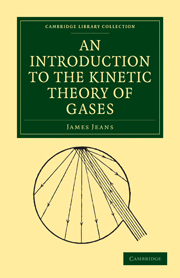Book contents
- Frontmatter
- PREFACE
- Contents
- CHAP. I Introduction
- CHAP. II A Preliminary Survey
- CHAP. III Pressure in a Gas
- CHAP. IV Collisions and Maxwell's Law
- CHAP. V The Free Path in a Gas
- CHAP. VI Viscosity
- CHAP. VII Conduction of Heat
- CHAP. VIII Diffusion
- CHAP. IX General Theory of a Gas not in a Steady State
- CHAP. X General Statistical Mechanics and Thermodynamics
- CHAP. XI Calorimetry and Molecular Structure
- App. I Maxwell's proof of the Law of Distribution of Velocities
- App. II The H-theorem
- App. III The Normal Partition of Energy
- App. IV The Law of Distribution of Coordinates
- App. V Tables for Numerical Calculations
- App. VI Integrals involving Exponentials
- Index of Subjects
- Index of Names
CHAP. X - General Statistical Mechanics and Thermodynamics
Published online by Cambridge University Press: 07 September 2010
- Frontmatter
- PREFACE
- Contents
- CHAP. I Introduction
- CHAP. II A Preliminary Survey
- CHAP. III Pressure in a Gas
- CHAP. IV Collisions and Maxwell's Law
- CHAP. V The Free Path in a Gas
- CHAP. VI Viscosity
- CHAP. VII Conduction of Heat
- CHAP. VIII Diffusion
- CHAP. IX General Theory of a Gas not in a Steady State
- CHAP. X General Statistical Mechanics and Thermodynamics
- CHAP. XI Calorimetry and Molecular Structure
- App. I Maxwell's proof of the Law of Distribution of Velocities
- App. II The H-theorem
- App. III The Normal Partition of Energy
- App. IV The Law of Distribution of Coordinates
- App. V Tables for Numerical Calculations
- App. VI Integrals involving Exponentials
- Index of Subjects
- Index of Names
Summary
203. So far our molecules have been treated either as elastic spheres, exerting no forces on one another except when in actual collision, or else as point centres of force, attracting or repelling according to comparatively simple laws. The time has now come to discard all such restrictions, and treat the question in a more general way, regarding the molecules as general mechanical structures, which may be as complicated as we please, consisting of any number of parts, capable of any kind of internal motion and exerting upon one another forces of any type.
Degrees of Freedom
204. The total number of independent quantities which are needed to specify the configuration of any mechanical system is called the number of degrees of freedom of the system. This number does not depend on the motions, but on the capacities for motion, of the various parts of the system; it is therefore related to the geometrical or kinematical, and not to the mechanical, properties of the system.
For example, if a point is free to move in space, its position can be specified by three quantities, as for instance x, y, z, the rectangular coordinates of the point, so that a point which is free to move in space has three degrees of freedom.
- Type
- Chapter
- Information
- An Introduction to the Kinetic Theory of Gases , pp. 253 - 274Publisher: Cambridge University PressPrint publication year: 2009First published in: 1940

